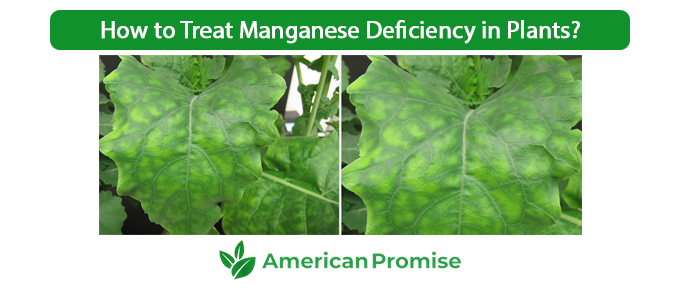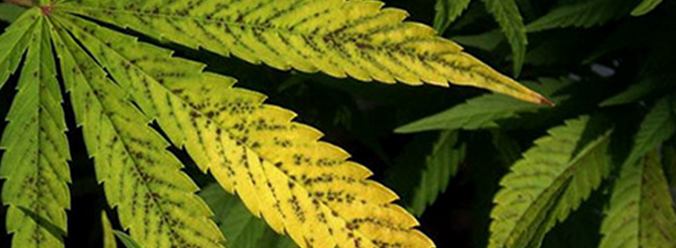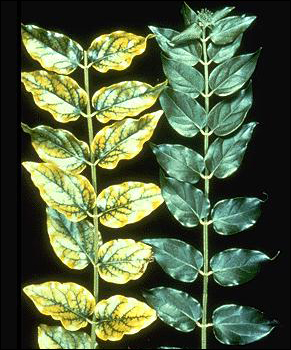We occasionally recommend products we love and might be paid a share of the sale.
Gardening is an art. Growing plants is no easy task. One has to know the plant requirements to maintain the plant’s health. While some grow plants to get direct benefits out of it such as vegetables, fruits, and flowers, some engage in it as a hobby. Irrespective of the motives and reasons, plants thrive only when conditions are right and requirements are adequate.
Just like humans, plants require nutrients for their overall growth and development. Some of these include nitrogen, potassium, magnesium, calcium, oxygen, carbon, etc. If plants are deficient in these nutrients, it will affect their growth and appearance. This article let us know about manganese deficiency in plants and how to treat them.
Role of Manganese in plants
Every living being requires nutrients and growth factors to help them maintain their overall health and growth. Concerning plants, water alone cannot keep them happy. Plants require numerous essential nutrients for their growth and development. Manganese is one of the nutrients crucial for plants to stay healthy.
We’re sure you might have heard xof photosynthesis in plants? Manganese is required for plants to carry out photosynthesis. Apart from photosynthesis, Manganese is also vital for the plant’s respiration, oxidation, nitrogen metabolism, enzymes synthesis, chlorophyll production, and formation of the chloroplast.
If plants lack Manganese, they will be not able to perform their usual routine to the fullest, causing growth and developmental problems. The efficiency of photosynthesis in plants depends upon the presence of Manganese. If plants are Manganese deficient, photosynthesis will not occur at its best. And, you know how photosynthesis is the key to plant survival.
Manganese helps the plant roots get resistant to harmful pathogens, help in the germination of pollens, and growth of pollen tubes. One of the important benefits of Manganese to plants is immunity building. Plants rich in Manganese have better immunity against pests or pathogens.
Now that you know the indispensable role Manganese plays in plant growth, you’d have naturally understood how harmful it can be for the plants to lack Manganese. Manganese deficiency can be identified at an early stage and prevented. You can save your plant from bigger damage if you take appropriate measures at the earliest. So, it’s important to know the symptoms of Magnesium deficiency in plants.
How to identify Manganese deficiency in plants?
Many confuse Manganese deficiency in plants with iron deficiency. It is no mistake, as Manganese deficiency usually occurs along with iron deficiency. So, before diving into the symptoms of Manganese deficiency in plants, we will brief you on the difference between Manganese deficiency and iron deficiency.
- Mostly, Manganese deficiency and iron deficiency in plants come together at the same time. Manganese deficiency results in leaves getting tanned along their veins, while iron deficiency results in white spots or patches on the leaves. Now, coming back to Manganese deficiency here is how to identify Manganese deficiency in your plant.
- Manganese deficiency first affects the younger leaves. You might notice the leaves turning pale. The paleness can be spotted in younger leaves and leaves in the upper area.
- Over time, the leaves can develop brown or black spots along their veins. These spots will be visible on the leaves’ lower sides.
- The brownish or blackish spots can lead to the collapse or complete damage of the leaves if not treated at an early stage.
- The edges of the leaves may turn yellow. This is also called leaf burn. Manganese deficiency usually affects newly growing parts and leaves.
- As Manganese deficiency disrupts photosynthesis, you may see a difference in plant quality and growth over time.
- The leaves may curl up and develop necrotic spots. The leaf shape may also be affected. Deformed leaves with decreased sizes can also occur.
- Manganese deficiency can cause interveinal chlorosis in young leaves. Interveinal chlorosis is nothing but the occurrence of yellow spots or patches in leaves. The tissue between the veins of leaves gets yellow because of a decrease in the production of chlorophyll.
Apart from these, there are no distinctive symptoms to identify Manganese deficiency in plants. Other nutrient deficiencies may also result in similar symptoms. So, it is practically quite hard to decide if your plant is Manganese deficient. You can get a sample of your plant and engage in lab testing to accurately measure the Manganese deficiency. You can check the soil or medium along with normal and abnormal plants to confirm Manganese deficiency.
Manganese toxicity
What is Manganese toxicity? Manganese deficiency is the lack of adequate Manganese in plants. Manganese toxicity refers to the over intake of Manganese by plants, which can turn toxic to plants’ health. Manganese toxicity can occur due to reasons such as less pH in soil, stagnated water, and excessive usage of fungicides.
If a plant is suffering from Manganese toxicity, you can see severe pale or yellow spots on the younger leaves and older leaves. To treat Manganese toxicity, you can increase the soil pH, clear out waterlogging and avoid using more amounts fungicides.
If Manganese toxicity is caused by waterlogging, you may notice the symptoms slowly reducing and the plant getting back to normal health once the soil gets dry. So, Manganese toxicity can be quickly treated if you rightly notice the symptoms. Now, let us know how to treat Manganese deficiency in plants.
Effective ways to treat Manganese deficiency in plants
Manganese deficiency usually occurs on organic soils, tropical soils, soils with pH > 6, and sandy soils. Some crops like palm crops, cereals, citrus, canola and legumes are easily prone to Manganese deficiency. You can take a sigh of a deep breath as Manganese deficiency is not at all difficult to treat. You can easily restore Manganese to your plants through the following ways:
- Foliar feed your plant
You can try foliar feeding to your plants that are Manganese deficient. Foliar feeding refers to providing essential nutrients to plants by spraying fertilizers mixed with water over leaves or soil. By doing so, the plant is believed to directly absorb the nutrients. You can use a Manganese foliar feed fertilizer for your Manganese deficient plants.
Foliar feed has proven to be one of the effective solutions for nutrient deficiency of plants. Manganese sulfate can be bought from stores and used. Make sure you dilute the fertilizer with water well enough at the correct amount. Otherwise, excessive nutrients may cause nutrient burns. You could also water the area and then spread Manganese sulfate for effective absorption by the soil.
- Altering soil pH
You can also try altering the pH level of the soil and balance nutrient contents in the soil by getting your hands on organic control. You can purchase such organic matter from reliable sources or stores. The organic matter will alter the water holding tendency of the soil and its pH levels to treat Manganese deficiency.
- Get expert advice
If you are apprehensive about taking your call for treating Manganese deficiency in your plants, you can get in touch with agricultural experts and professional plant growers. There are exclusive sites online to help you out. But, make sure you get in touch with a trustworthy source. According to the plant type, and soil type, the expert will suggest appropriate ways to treat Manganese deficiency in your plants.
The above-mentioned ways will help you treat Manganese deficiency in plants.
Can you prevent Manganese deficiency in plants?
Yes. It will save you a lot of time and effort if you prevent an issue rather than treat it. Manganese deficiency in plants can be prevented if you put a little extra effort into taking care of your plants.
- While using fertilizers to increase your plant growth and harvest, ensure you use them at a balanced and correct amount. Too many fertilizers can also harm your plant. The right amount of dilution of fertilizers is necessary to prevent nutrient burns. Do not directly use Manganese sulfate fertilizer on soil or leaves. Dilute it in half ratio and water the soil before sprinkling the fertilizer, so the soil readily absorbs the nutrients.
- You can keep the soil stable and healthy by using organic mulch. Organic mulch refers to natural materials that can decompose easily in the soil. This includes banana peels, grass clippings, sawdust, stale vegetables, paddy or wheat straw, crop residue, etc. Organic mulch keeps the soil free from chemicals and also enhances plant growth.
- Never over-water your plant. Sometimes we accidentally over-water our plants. Overwatering plants can lead to waterlogging. Waterlogging is one of the causes of Manganese deficiency. You can try building a good drainage system for your plants to prevent water from stagnant.
- Soil pH can increase or decrease due to different reasons. Maintaining optimal soil pH is essential for plants to absorb nutrients efficiently. Therefore, adjust soil pH according to your plant requirements and nutrient deficiencies.
- Last but not least, monitoring your plant regularly is important to identify even the smallest issues. If you have no interest to monitor your plants, you might not notice problems at an early stage and this will lead to bigger damages over time. If your plant leaves turn brown or yellow, try to know what caused it. By constant monitoring, you can also identify serious pest infestations or plant diseases. Early detection will help you take appropriate measures for the well-being of your plants.
Factors to consider before beginning nutrient deficiency treatment
After concluding nutrient deficiency in plants, you may get ready to begin the appropriate treatment for your plants. Before you implement the treatment, make sure you consider a few factors, as the plant’s diminishing health may also be due to other reasons.
- Plant insects or pests: Check if your plant has any pests, bugs or insects on them. If you didn’t know, pests can also cause discolouration of leaves. Your plant’s growth may be affected by pests too. So, check for pests or plant diseases before concluding about nutrient deficiency and starting the treatment.
- The pH of the soil: Soil pH plays a vital role in helping your plants absorb nutrients. If the pH is too low or too high, that will affect the nutrient intake of plants. Hence, you should alter the soil pH and see if it is at the optimal range. At times, the soil may be too alkaline or too acidic. This might have caused issues.
- Water quality: Water from different regions comes with different mineral and nutrient compositions. Some water may be too hardy. The water composition can influence the plant’s nutrient absorption. Therefore, you could lab test the water composition to know if you’ve been feeding suitable water for your plants.
- Temperature and humidity: Some plants require optimal temperature and humidity for good growth and development. If you’ve been keeping a warmer environment loving plant in a cold place, that might affect the plant growth. And, the plant may show symptoms such as poor growth, pale leaves, etc. So, measure the temperature and humidity and see if the plant is suitable to grow at the temperature at which you are keeping it.
What are other common nutrient deficiencies in plants?
Not just Manganese deficiency, plants are susceptible to various nutrient deficiencies such as
- Iron deficiency
- Zinc deficiency
- Boron deficiency
- Nickel deficiency
- Chlorine deficiency
- Copper deficiency
- Molybdenum deficiency
- Sulfur deficiency
- Magnesium deficiency
- Calcium deficiency
- Potassium deficiency
- Nitrogen deficiency and
- Phosphorus deficiency
While deficiencies in Nickel can occur rarely, deficiencies in Magnesium, iron, phosphorus, nitrogen, zinc, boron and sulfur are quite common.
We hope you have understood how important nutrients are for plant growth and development. Every plant requires nutrients at optimal levels for its overall wellbeing. The problem with identifying nutrient deficiency in plants is, all the nutrient deficiencies more or less show similar symptoms. This might confuse plant growers. This is why it is the best idea to prevent any kind of nutrient deficiency by growing plants in the right way from the starting stage.
A rotating team of writers and editors dedicated to providing reliable information for the readers of American Promise. We’re all passionate about cannabis and actively engaged in this “budding” industry.
Contents





